new not English sound
Month: July 2018
REG 2 CAT MAN
REG 2 CAT MAN
REG1 CAT DAT
REG1 CAT DAT
H new REG
H new REG
303
303
Jordan 195
F1 RESTORATION
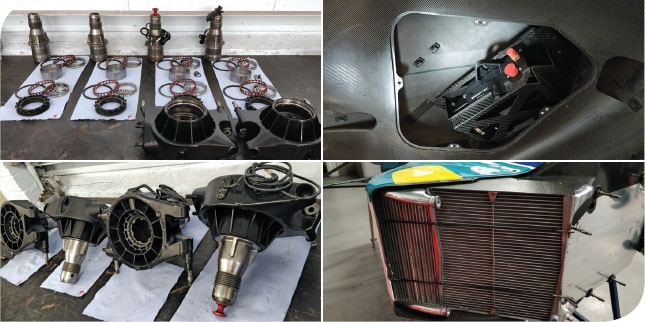
I don’t quite yet have a fully rebuilt and dyno-tested engine, but the good news is that the Peugeot internals have passed crack testing and there are, so far, no horrible surprises. I’m still itching to see — and hear — it up and running. I have never been in a dyno room with a V10 Formula 1 engine on full song. People who have tell me it’s one part awesome and one and a half parts terrifying.
In the meantime, we have started to put the final touches to the chassis build of my ex-Rubens Barrichello Jordan 195. The first job was fitting the fuel tank. The physical fitting is not a simple job, because the aperture through which it must pass to fit inside the monocoque is very small. All the foam inside must be removed then painstakingly refitted into the tank, along with the pump hardware. This means the guys at Tour-de-Force Power Engineering are essentially working blind most of the time.
The uprights have been stripped, crack-tested and rebuilt. Visually they appeared to look fine and non-destructive testing proved this to be the case. It’s only when they are apart that one can appreciate just how much design and manufacturing skill has gone into these components. The uprights on the car are fabricated from titanium with a machined centre. They are beautifully made.
I have been incredibly lucky to find another pair of front uprights to use as spares, but interestingly these are fabricated from steel. I can only guess that these were possibly off a test car. Before rebuilding the uprights, we re-greased the bearings, which themselves were in such good condition that they did not need replacing.
The radiators have also now been serviced. They were sent to an F1 radiator specialist at Silverstone to be ultrasonically cleaned and pressure tested. Apart from a minor repair needed to one small part of one radiator, everything else was perfect and they have now been mounted back on the car with fresh fittings and fasteners.
The Brembo brake callipers were in great condition and have been stripped, cleaned and rebuilt with new seals and fittings. Suitable carbon-carbon discs and pads were sourced. Carbon-carbon is an incredible material, but the braking system used in 1995 was relatively simple, certainly compared with the brake-by-wire and energy recovery systems of modern F1 cars.
The modern electronics have been mounted in the original box locations on the car, including the ECU above the fuel cell. New brackets were produced for the mounts in the tub and all components fit into the original recesses with the period closing panels. We can now move on and begin to build the wiring loom. We are also testing the original dash and cockpit electronics to ensure these are fit for purpose.
New front and rear dampers are being manufactured and should be on the car very soon. Engine permitting, we aim to give the car its shakedown test in the early spring at Snetterton, and I am hopeful that it may get one of its first public outings at the Goodwood Festival of Speed in July, followed by some demo runs at Brands Hatch in August and Jarama later in the summer.

Next month: final pre-testpreparations – and will Warren’s ears be ringing?
Thanks to: Tour-de-ForcePower Engineering, Bedford; Engine Developments, Rugby
Alfasud Sprint Veloce
RACER REBUILD
GARAGISTA
THIS MONTH ALFASUD SPRINT VELOCE MAKES FIRST PUBLIC APPEARANCE • JORDAN 195 REBUILD LATEST • MGB STRIPDOWN HIGHLIGHTS BAD NEWS
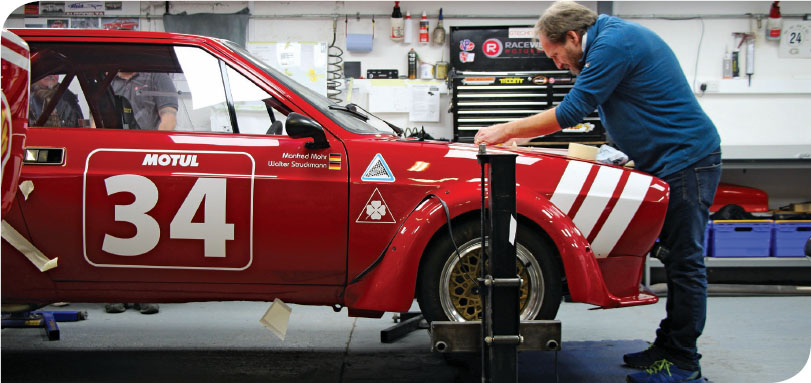
It was, I suppose, a slightly surreal feeling. The Alfa has been edging ever closer to completion over the past few months and I’ve followed progress every step of the way, but so many people have invested so much time in the project that I found it quite hard to believe the finished article was actually mine. I guess it will eventually sink in.
I’m thrilled to bits with the way it looks. Raceworks did a stunning job with my Giulietta – and the ’Sud looks every bit as good. I’m really not sure there’s anything they could have done to improve it and I can’t wait to try it for the first time. If all goes to plan it will have turned a wheel by the time you read this, most probably at Donington Park, and we’re hoping to get in a couple of sessions before heading off for the car’s debut race at Barcelona in early April. I’m still hoping Dickie Meaden will be able to share it with me at some meetings, though he is also committed to driving Gérard Lopez’s Ford Capri. When Dickie isn’t available, I guess I’ll probably race solo. The programme for the year is now pretty settled: Peter Auto’s Heritage Touring Cup, plus the Donington Historic Festival in May and July’s Silverstone Classic.
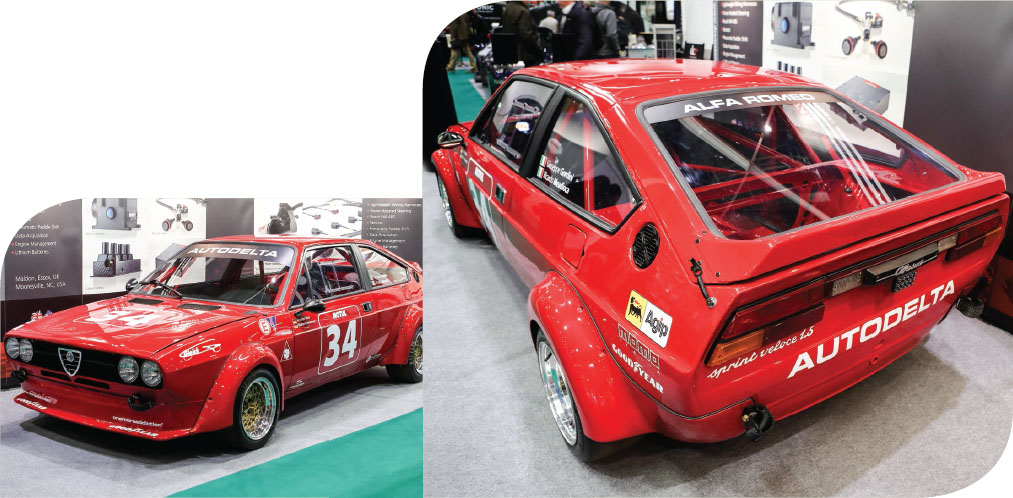
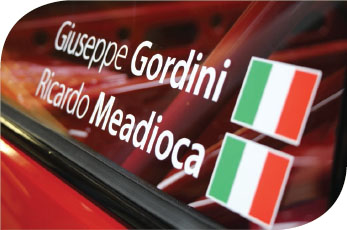
It was a busy event and there were presentations to several well-known former Alfa drivers, including Carlo Facetti, while Gianluigi Picchi was also present. He was prominent in the European Touring Car Championship during the early 1970s: in 1971 he won his class in a 1300 GTA Junior and finished second overall to Capri driver Dieter Glemser.
I’ve always known that Alfa really treasured its racing past – and this confirmed it. I travelled to Milan with long-time Alfa Romeo aficionado Jon Dooley, who used to contest the British Saloon Car Championship in ’Suds and GTV6s. Jon has been a great help in terms of researching the Alfasud Sprint’s Gp2 racing history – and stayed on in Milan after I had left, to meet the Albertinazzi family at EPA Power. Giovanni Albertinazzi built, prepared and raced Gp2 Sprints in both 1.3- and 1.5-litre form back in the day, so we are gradually building up a portfolio of valuable information.
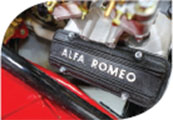
Next month: first impressions from behind the wheel
Thanks to: Raceworks, Characters Signs, DC Electronics
We’ve applied for the Alfa’s historic technical passport (HTP) – ours is the first Gp2 ’Sud Sprint Veloce to have been prepared in modern times – FIA inspector Jim Lowry is on the case and, as planned, I’ve booked a couple of one-to-one coaching sessions with John Norrington. My only previous front-wheel-drive experience has been on the public road, so I’m aware that I have a bit of learning to do…
HISTORIC RACER
MGB Roadster
A few tweaks are in train for the new season – such as new brakes and a rebuilt gearbox. Oh, and the heavy bit up front. Nick Trott takes up the story…
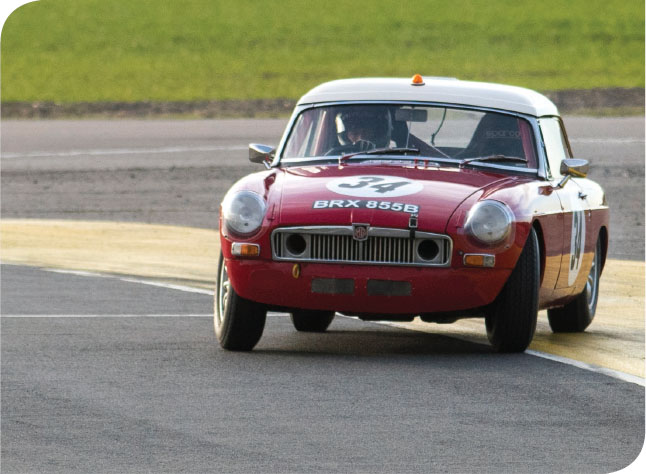
Ithink we’re going to be late for the season openers. We were hoping to get on the grid for the Equipe GTS trackday at Goodwood on March 5, then the season opener at Silverstone on the 7th, but we’ve found a few other issues with the MGB that need sorting. One of them is quite a big, heavy issue…
Firstly the good news. The gearbox, traditionally a weak point on MGBs, is rebuilt. It’s easy to destroy the innards with imprecise heel-and-toeing and/or rushing the shifts, and small issues seem to turn into big problems quite quickly. As an MGB driver, you have to remember that in the rush and fury of racing slow is best when shifting cogs – its counter-intuitive but absolutely crucial. We plan to keep the ’box in tip-top condition throughout the season, and into 2019 hopefully, and avoid a mid-season rebuild like last year.
The suspension and brakes are also fitted – two areas that we believe were weak points last year. We’re hoping for better performance and stability all round, with fewer ‘bad habits’. For instance the B was always one of the more, um, sideways cars on the grid but despite the its crowd-pleasing antics we’d really rather it wasn’t quite so drifty.
Roll oversteer was the key problem throughout 2017, and we’re hoping to have this cured with new parabolic leaf springs and general set up changes. Less entertaining for the spectator (and drivers) but faster, we hope.
Finally, the big heavy issue. With the cylinder head removed an inspection of the bores revealed a rather tired block. A new one isn’t criminally expensive, which is the case for pretty much everything on the MGB to be honest, so owner Ed has ordered a new block.
So yes, we’ll be late for the first races of 2018 – but it’ll be worth the wait. BRX 855B will be fitter and faster than ever. Probably about time its drivers were too…
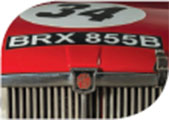
Next month: Removing the dents, tidying up the shell in preparation for the bodywork rebuild.
Thanks to: Roy Gillingham of
www.chequeredflagclassics.co.uk
Once painting and assembly were complete, and the final graphics had been applied, the Sprint made its public debut at the London Classic Car Show, in mid-February at ExCeL, and immediately received some very positive feedback via social media. I wasn’t able to attend the show myself, but had a very worthwhile excuse – a clashing fixture in Italy.
I’d been invited to the annual Scuderia del Portello ceremony at the Museo Storico Alfa Romeo, which forms part of the site where the marque’s old Arese factory once stood, in Milan. We were up for an award for our team’s performance with the Giulietta Ti at the 2017 Goodwood Revival, when Dickie Meaden and Steve Soper finished second on aggregate in the St Mary’s Trophy. It was great to get such recognition for our efforts with historic Alfas – a real honour, especially in such distinguished company.
SPEEDSHOP
TOP STORY
BUYING • SELLING • AUCTIONS • RACE & ROAD CAR PROFILES
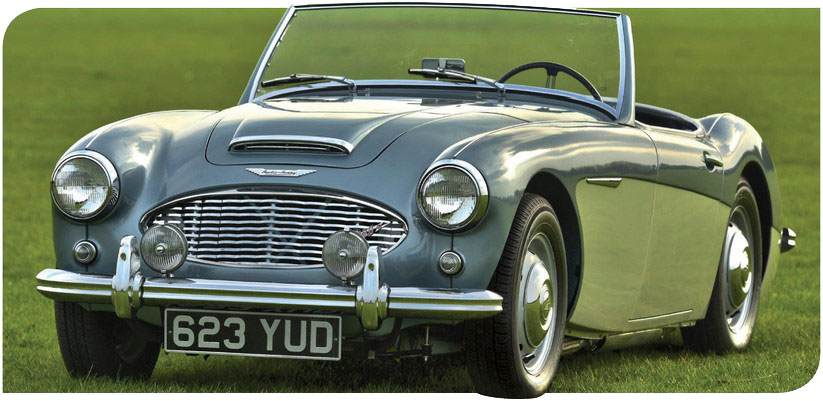
Double-barrelled diehard
Muscular British classic that scored competition successes galore
Big Healey – sounds like a character in a gangster film, no? Someone brawny, tough, determined. And there’s a lot in that. Donald Healey’s co-production with the far larger Austin company, under its BMC umbrella, resulted in a sports car with just those qualities, as proved in major rallies and plenty of racing. A car boasting period credentials in those events has become much coveted, but with heading for 60,000 Austin-Healeys built in several variants, they offer plenty of choice for the enthusiast buyer. The car Vintage & Prestige has in stock, in the desirable BN6 spec, did its bit for Britain’s ‘export or die’ campaign – built at MG’s Abingdon works in 1958 with left-hand drive, it went straight to San Francisco and put treasured dollars into the home economy.
After 32 years the car returned to a home in Jersey and has recently had a complete restoration to concours standard, with just about everything checked, reconditioned or if necessary replaced (including valves and valve seats to utilise unleaded fuel). Casual onlookers may easily miss the differences and assume it’s a Healey 3000, but this earlier model is a 100/6 – pretty similar but lacking 400 of the ccs in its big brother’s title. Whereas the first Austin-Healeys made the most of a four-cylinder Austin A90 engine, the 100/6 upgraded to a big six from the Westminster saloon and, although it was hardly sophisticated, the new 2.6-litre pushrod engine was sturdy and simple to fix. Unshackled from the weighty Westminster it brought enough horsepower to make the Healey lively on the road. In truth the extra weight of the six cancelled out its power until, in 1958, a new 12-port head and manifold raised the figure from 102 to 117bhp. That’s the spec of this BN6 model, the final iteration before the bigger-engined 3000 arrived.
Healey redesigned his car to swallow the longer six-cylinder engine, increasing the length by six inches and making an already attractive design even better proportioned, especially with the sweeping two-tone paint option in classic ice blue over white. At first you could have a couple of cramped perches in the rear, but that wasn’t popular and disappeared with the arrival of the BN6.
With its drum brakes and ladder chassis the 100/6 offered no technical innovation; Healey very sensibly chose simple, affordable parts from the generally uninspiring Austin range, relying on weight loss and million-dollar looks for sales appeal. Sports cars famously generate low volumes and similar profit margins, but are essential to chrome-plating your market image, which is why BMC’s Leonard Lord pounced on the single example the Healey company built and showed at the 1952 British Motor Show. He needed a ‘halo car’ and here was one ready-made, using parts from his range. Overnight he made a deal with Healey, the car’s name became double-barrelled and Healey’s firm went from turning out hand-built vehicles to being a maker recognised across Europe and America. In 3000 MkI and II form the Big Healey would survive until 1968, but the car’s extrovert character and its huge competition success ensures that in all its versions it remains a favourite from Britain’s golden era of sports cars.
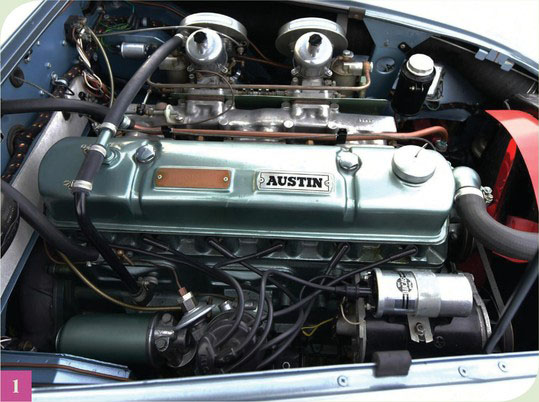
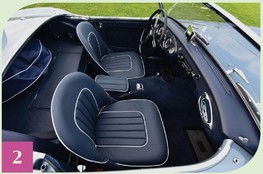
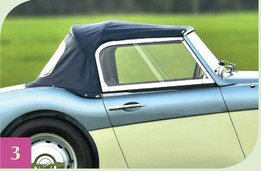
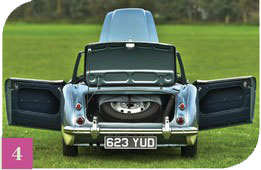
Burning ambition
Who would have thought, even five years ago, that a Kia would have earned its place on these pages? The Korean duo of Kia and Hyundai have made some incredible in-roads into the more mainstream, affordable parts of the market and have done so on merit with credible products backed by first-rate warranties, but this new Kia Stinger is a sports saloon costing more than £40,000, a price point that pitches it not against VW and Vauxhall, but BMW, Audi and Mercedes-Benz. Can it possibly compete?
On paper, absolutely. You may or may not like the look of the Stinger but you can’t argue with hardware: though four-cylinder petrol and diesel models are available, this flagship comes with a turbocharged V6 developing 365bhp and driving the rear wheels alone through an eight-speed automatic gearbox.
And, at the risk of sounding faintly patronising, it’s a very good first attempt at such a car. The engine is responsive, the gearbox smooth enough and clearly a lot of attention has been lavished on suspension tuning because the Stinger not only rides well, it controls its body movements very capably, too. I spent a week in it and, the odd electronic chime aside, it annoyed me hardly at all and most of the time provided swift, pleasant and capable transport. Indeed it gets closer to the standards set by its new found German opposition than I had expected. So hats off to Kia for that.
There are just two problems. The first is that there are no consolation prizes in any part of the market, let alone one peopled with product as capable as that into which Kia is now venturing. True, the Stinger is a little cheaper than the best Europe can offer, but so it should be because getting close to the establishment is not really good enough: if a car like the Stinger is to tempt people out of their BMW 440i Gran Coupés and suchlike, it really needs to offer something they lack – and it doesn’t. Its interior is not so classy, its chassis not quite so multi-faceted. And while it is undoubtedly powerful, so too does it need to be as the Stinger is exceptionally heavy: more than 1900kg at the kerb while the BMW weighs in at less than 1700kg. This means not only blunted performance, but fairly catastrophic fuel consumption too, worse on paper than a Porsche 911 Turbo S with another 200bhp…
There’s also something else, which shouldn’t be a factor but clearly will be. We are a nation of unconscionable badge snobs. I wish Kia all the best in the world with the Stinger, because I like it when car companies try to do something different and difficult, but it’s hard to see many people passing by all those posh German prestige brands and explaining to their friends and family why there’s a Kia on the drive. Like I said, it shouldn’t be an issue, but I guarantee it will be.
It’s a shame because in isolation the Stinger is a good car. But as we’ve seen so many times before from companies that have tried to steal some business from the old European blue bloods, good just isn’t good enough.

FACTFILE
Kia Stinger GTS
Price £40,495 Engine 3.3 litres, 6 cylinders, turbocharged Power 365bhp@6000rpm Torque 376lb ft@1300rpm Weight 1909kg Power to weight 191bhp per tonne Transmission eight-speed automatic, rear-wheel drive 0-62mph 4.9sec Top speed 169mph Economy 28.8mpg CO2 225g/km
Style with more substance
This might seem a contentious thing to say but in my experience it is true: big 12-cylinder saloons are hardly ever as good as their more modestly powered brethren.
I have, for instance, never driven a Mercedes-Benz S600 or S65 with its 6-litre V12 that I preferred to a similar car powered by merely eight cylinders.
I’ve not yet driven the 12-cylinder version of the all new Audi A8, but I never drove one of its predecessors and concluded that it was the best of the range, despite being the by far the most expensive.
Indeed, the closest I’ve come to seeing the sense in such a car is with this new BMW M760Li, which is as charming a 12-pot limousine as you’ll find this side of a Rolls-Royce Ghost whose 6.6-litre engine, incidentally, it shares.
What’s different about it?
For a start, it has a wonderful motor, better by far than the ancient V12 used by Mercedes and both smoother and more sonorous than the Bentley/Audi W12. It’s silent when you want it to be and has a deep, rich and complex note when extended. It also throws the 7-series down the road at a quite preposterous rate, for right now this the fastest accelerating BMW you can buy.
Actually it’s even better than that because it’s not just far more capable on a difficult road than you’d imagine (thank standard four-wheel drive and four-wheel steering for that), it’s even reasonably entertaining, at least by the standards of such cars.
There are a few downsides, particularly ride quality that is good rather than superb and an interior that looks too closely related to far cheaper BMWs, but as the first 7-series to wear an M-badge, even if it is not a proper M-car itself, BMW has judged it nicely.
It is first and foremost a large and very luxurious saloon, but with a frisson of dynamism I’ve not experienced in other cars of this ilk.
Whether it is worth £135,340 is another question. On the one hand it seems barely believable that it should cost more than twice as much as the entry level 7-series, even in long-wheelbase configuration and, were you to take the plunge, I’d try to think very hard about likely depreciation beforehand and not at all thereafter.
On the other hand it is probably the best car of its kind out there at present.
Even so I’d still struggle to recommend it over a lesser diesel 7-series because, for almost everyone almost all the time, something like a 740d will not just be cheaper but, in certain critical ways, better too, not least in terms of its ability to travel at least twice as far on a tank of fuel.
All I would say to those people who buy such cars, because it is important to them to have the flagship model, is that while they might be spending a lot of money on what is probably not the best BMW 7-series, I can see a case for it beyond mere vanity.
And that is something I have often struggled to do with any of its erstwhile rivals.

FACTFILE
BMW M760Li
Price £138,265 Engine 6.6 litres, 12 cylinders, turbocharged Power 600bhp@5500rpm Torque 590lb ft@1550rpm Weight 2255kg Power to weight 266bhp per tonne Transmission eight-speed automatic, four-wheel drive 0-62mph 3.7sec Top speed 155mph Economy 22.1mpg CO2 291g/km